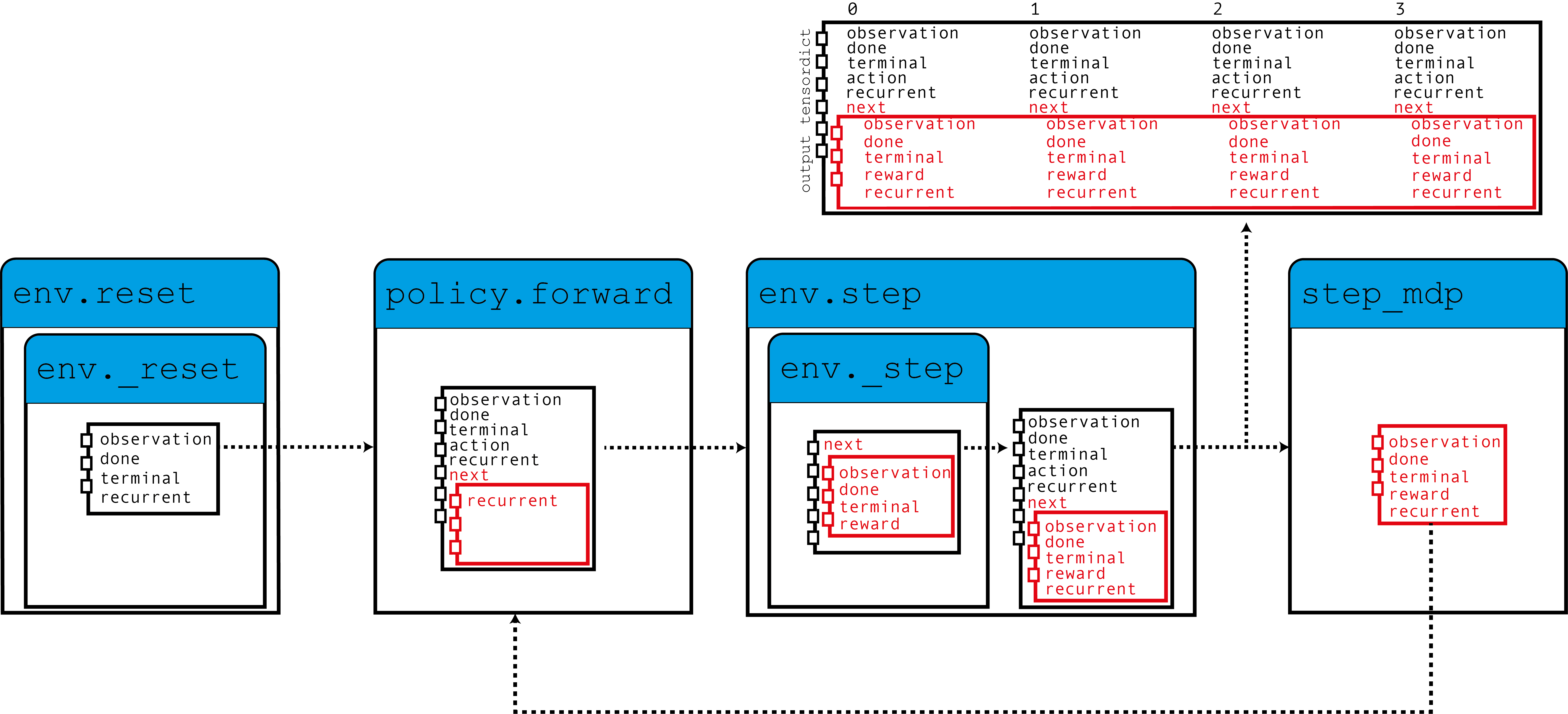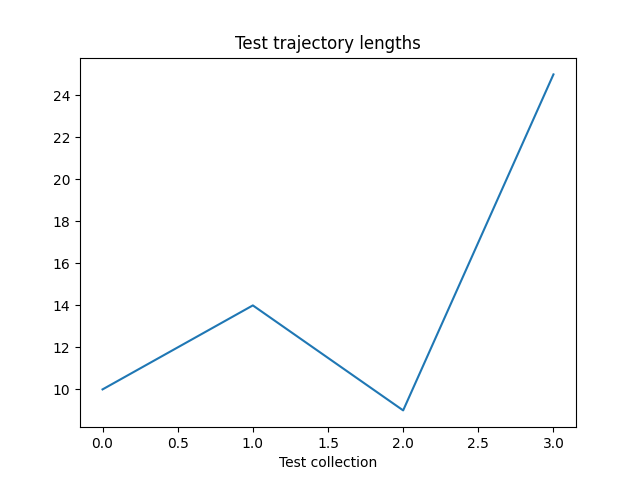注意
转到末尾下载完整的示例代码。
循环 DQN:培训循环策略¶
作者: Vincent Moens
如何在 TorchRL 的 actor 中加入 RNN
如何将基于内存的策略与 replay buffer 和 loss 模块一起使用
PyTorch 版本 v2.0.0
健身房[Mujoco]
TQDM
概述¶
基于内存的策略不仅在观察部分时至关重要 observable 的,但当必须将时间维度考虑为 做出明智的决策。
长期以来,递归神经网络一直是基于内存的流行工具 政策。这个想法是将内存中的递归状态保持在两个 连续步骤,并将其与 目前的观察。
本教程介绍如何使用 TorchRL 将 RNN 合并到策略中。
主要学习内容:
在 TorchRL 的 actor 中合并 RNN;
将基于内存的策略与 replay buffer 和 loss 模块一起使用。
在 TorchRL 中使用 RNN 的核心思想是使用 TensorDict 作为数据载体 对于从一个步骤到另一个步骤的隐藏状态。我们将构建一个策略,以便 从当前 TensorDict 中读取之前的 recurrent 状态,并将 当前 recurrent 状态在下一个状态的 TensorDict 中:

如图所示,我们的环境使用归零的 recurrent 填充 TensorDict
state 中,这些 state 被 policy 与 observation 一起读取,以产生一个
action 和将用于下一步的 recurrent 状态。
当step_mdp()函数时,循环状态
从下一个状态带到当前 TensorDict。让我们看看这个
在实践中实现。
如果您在 Google Colab 中运行此程序,请确保安装以下依赖项:
!pip3 install torchrl
!pip3 install gym[mujoco]
!pip3 install tqdm
设置¶
import torch
import tqdm
from tensordict.nn import (
TensorDictModule as Mod,
TensorDictSequential,
TensorDictSequential as Seq,
)
from torch import nn
from torchrl.collectors import SyncDataCollector
from torchrl.data import LazyMemmapStorage, TensorDictReplayBuffer
from torchrl.envs import (
Compose,
ExplorationType,
GrayScale,
InitTracker,
ObservationNorm,
Resize,
RewardScaling,
set_exploration_type,
StepCounter,
ToTensorImage,
TransformedEnv,
)
from torchrl.envs.libs.gym import GymEnv
from torchrl.modules import ConvNet, EGreedyModule, LSTMModule, MLP, QValueModule
from torchrl.objectives import DQNLoss, SoftUpdate
is_fork = multiprocessing.get_start_method() == "fork"
device = (
torch.device(0)
if torch.cuda.is_available() and not is_fork
else torch.device("cpu")
)
环境¶
像往常一样,第一步是构建我们的环境:它帮助我们 定义问题并相应地构建策略网络。在本教程中, 我们将运行一个基于 Pixel 的 CartPole 健身房实例 环境进行一些自定义转换:变为灰度,调整为 84x84,缩小奖励并使观察结果正常化。
注意
这StepCountertransform 是 compory。自 CartPole
任务目标是尽可能长地绘制轨迹,计算步数
可以帮助我们跟踪策略的执行情况。
对于本教程而言,有两个转换非常重要:
InitTracker将对 调用reset()通过在 TensorDict 中添加一个布尔掩码来跟踪哪些步骤需要重置 的 RNN 隐藏状态。"is_init"这
TensorDictPrimertransform 要多一点 专门的。不需要使用 RNN 策略。但是,它 指示环境(以及随后的收集器)将一些额外的 键是意料之中的。添加后,将填充对 env.reset() 的调用 Primer 中用零张量指示的条目。知道 这些张量是策略所期望的,收集器会将它们传递给 在收集期间。最终,我们将把隐藏的状态存储在 replay 缓冲区,这将帮助我们引导 loss 模块中的 RNN作(否则将启动 替换为 0)。总之:不包括此转换不会产生太大影响 训练我们的政策,但它会让反复出现的钥匙消失 从收集的数据和重放缓冲区,这反过来又会导致 稍微不那么理想的训练。 幸运的是,LSTMModule我们建议是 配备了一个 helper 方法来为我们构建该转换,因此 我们可以等到我们构建它!
env = TransformedEnv(
GymEnv("CartPole-v1", from_pixels=True, device=device),
Compose(
ToTensorImage(),
GrayScale(),
Resize(84, 84),
StepCounter(),
InitTracker(),
RewardScaling(loc=0.0, scale=0.1),
ObservationNorm(standard_normal=True, in_keys=["pixels"]),
),
)
与往常一样,我们需要手动初始化我们的归一化常量:
env.transform[-1].init_stats(1000, reduce_dim=[0, 1, 2], cat_dim=0, keep_dims=[0])
td = env.reset()
政策¶
我们的政策将包含 3 个组成部分:一个ConvNetbackbone、LSTMModule内存层和浅层MLP块,该块会将 LSTM 输出映射到
action 值。
卷积网络¶
我们构建了一个卷积网络,其两侧有一个torch.nn.AdaptiveAvgPool2d这将压缩大小为 64 的向量中的输出。这ConvNet可以协助我们:
feature = Mod(
ConvNet(
num_cells=[32, 32, 64],
squeeze_output=True,
aggregator_class=nn.AdaptiveAvgPool2d,
aggregator_kwargs={"output_size": (1, 1)},
device=device,
),
in_keys=["pixels"],
out_keys=["embed"],
)
我们对一批数据执行第一个模块,以收集 输出向量:
n_cells = feature(env.reset())["embed"].shape[-1]
LSTM 模块¶
TorchRL 提供了一个专门的LSTMModule类
将 LSTM 合并到您的代码库中。它是一个子类:因此,它有一组 and 表示
在
执行模块。该类带有可自定义的预定义
值来促进其构造。TensorDictModuleBasein_keysout_keys
注意
使用限制:该类支持几乎所有 LSTM 功能,例如
dropout 或多层 LSTM。
但是,为了遵守 TorchRL 的约定,此 LSTM 必须将属性设置为 PyTorch 中的默认值。然而
我们batch_firstTrueLSTMModule更改此默认值
行为,因此我们擅长使用 native 调用。
此外,LSTM 不能将属性设置为
这在在线设置中不可用。在这种情况下,默认值
是正确的。bidirectionalTrue
lstm = LSTMModule(
input_size=n_cells,
hidden_size=128,
device=device,
in_key="embed",
out_key="embed",
)
让我们看看 LSTM Module 类,特别是它的 in 和 out_keys:
print("in_keys", lstm.in_keys)
print("out_keys", lstm.out_keys)
in_keys ['embed', 'recurrent_state_h', 'recurrent_state_c', 'is_init']
out_keys ['embed', ('next', 'recurrent_state_h'), ('next', 'recurrent_state_c')]
我们可以看到,这些值包含我们指示为 in_key 的键(和 out_key)
以及循环键名称。out_keys前面有 “next” 前缀
这表明它们需要写入 “next” TensorDict 中。
我们使用此约定(可以通过传递 in_keys/out_keys
参数),以确保对step_mdp()将
将 recurrent 状态移动到根 TensorDict,使其可用于
RNN (参见简介中的图)。
如前所述,我们还有一个可选的转换要添加到我们的
environment 来确保将递归状态传递给缓冲区。
这make_tensordict_primer()method 执行
正是这样:
env.append_transform(lstm.make_tensordict_primer())
TransformedEnv(
env=GymEnv(env=CartPole-v1, batch_size=torch.Size([]), device=cpu),
transform=Compose(
ToTensorImage(keys=['pixels']),
GrayScale(keys=['pixels']),
Resize(w=84, h=84, interpolation=InterpolationMode.BILINEAR, keys=['pixels']),
StepCounter(keys=[]),
InitTracker(keys=[]),
RewardScaling(loc=0.0000, scale=0.1000, keys=['reward']),
ObservationNorm(keys=['pixels']),
TensorDictPrimer(primers=Composite(
recurrent_state_h: UnboundedContinuous(
shape=torch.Size([1, 128]),
space=ContinuousBox(
low=Tensor(shape=torch.Size([1, 128]), device=cpu, dtype=torch.float32, contiguous=True),
high=Tensor(shape=torch.Size([1, 128]), device=cpu, dtype=torch.float32, contiguous=True)),
device=cpu,
dtype=torch.float32,
domain=continuous),
recurrent_state_c: UnboundedContinuous(
shape=torch.Size([1, 128]),
space=ContinuousBox(
low=Tensor(shape=torch.Size([1, 128]), device=cpu, dtype=torch.float32, contiguous=True),
high=Tensor(shape=torch.Size([1, 128]), device=cpu, dtype=torch.float32, contiguous=True)),
device=cpu,
dtype=torch.float32,
domain=continuous),
device=cpu,
shape=torch.Size([])), default_value={'recurrent_state_h': 0.0, 'recurrent_state_c': 0.0}, random=None)))
就是这样!我们可以打印环境以检查现在一切看起来是否正常 我们添加了引物:
print(env)
TransformedEnv(
env=GymEnv(env=CartPole-v1, batch_size=torch.Size([]), device=cpu),
transform=Compose(
ToTensorImage(keys=['pixels']),
GrayScale(keys=['pixels']),
Resize(w=84, h=84, interpolation=InterpolationMode.BILINEAR, keys=['pixels']),
StepCounter(keys=[]),
InitTracker(keys=[]),
RewardScaling(loc=0.0000, scale=0.1000, keys=['reward']),
ObservationNorm(keys=['pixels']),
TensorDictPrimer(primers=Composite(
recurrent_state_h: UnboundedContinuous(
shape=torch.Size([1, 128]),
space=ContinuousBox(
low=Tensor(shape=torch.Size([1, 128]), device=cpu, dtype=torch.float32, contiguous=True),
high=Tensor(shape=torch.Size([1, 128]), device=cpu, dtype=torch.float32, contiguous=True)),
device=cpu,
dtype=torch.float32,
domain=continuous),
recurrent_state_c: UnboundedContinuous(
shape=torch.Size([1, 128]),
space=ContinuousBox(
low=Tensor(shape=torch.Size([1, 128]), device=cpu, dtype=torch.float32, contiguous=True),
high=Tensor(shape=torch.Size([1, 128]), device=cpu, dtype=torch.float32, contiguous=True)),
device=cpu,
dtype=torch.float32,
domain=continuous),
device=cpu,
shape=torch.Size([])), default_value={'recurrent_state_h': 0.0, 'recurrent_state_c': 0.0}, random=None)))
MLP¶
我们使用单层 MLP 来表示我们将用于 我们的政策。
并用零填充偏差:
mlp[-1].bias.data.fill_(0.0)
mlp = Mod(mlp, in_keys=["embed"], out_keys=["action_value"])
使用 Q 值选择作¶
我们政策的最后一部分是 Q 值模块。
Q 值模块QValueModule将读取我们的 MLP 生成的密钥,并且
从中,收集具有最大值的作。
我们唯一需要做的就是指定动作空间,这可以做到
通过传递 String 或 action-spec 来执行。这允许我们使用
分类(有时称为“稀疏”)编码或其独热版本。"action_values"
qval = QValueModule(action_space=None, spec=env.action_spec)
注意
TorchRL 还提供了一个包装器类,该类
将模块包装在 Sequential 中,并使用torchrl.modules.QValueActorQValueModule就像我们在这里明确所做的那样。这样做几乎没有什么好处
并且该过程不太透明,但最终结果将类似于
我们在这里做什么。
我们现在可以将所有内容放在TensorDictSequential
stoch_policy = Seq(feature, lstm, mlp, qval)
DQN 是一种确定性算法,探索是其中的关键部分。
我们将使用 -greedy 策略,其中 epsilon 为 0.2 衰减
逐渐变为 0。
这种衰减是通过调用step()(请参阅下面的 Training Loop)。
exploration_module = EGreedyModule(
annealing_num_steps=1_000_000, spec=env.action_spec, eps_init=0.2
)
stoch_policy = TensorDictSequential(
stoch_policy,
exploration_module,
)
使用模型处理损失¶
我们构建的模型已经准备好用于顺序设置。
但是,类torch.nn.LSTM可以使用 cuDNN 优化的后端
在 GPU 设备上更快地运行 RNN 序列。我们不想错过
这样一个加快我们训练循环的机会!
要使用它,我们只需要告诉 LSTM 模块在 “recurrent-mode” 上运行
当被 Loss 使用时。
由于我们通常希望拥有两个 LSTM 模块的副本,因此我们通过以下方式实现
调用set_recurrent_mode()方法,该
将返回 LSTM 的新实例(具有共享权重),该实例将
假设输入数据本质上是连续的。
policy = Seq(feature, lstm.set_recurrent_mode(True), mlp, qval)
因为我们仍然有几个未初始化的参数,所以我们应该 在创建 Optimizer 等之前初始化它们。
policy(env.reset())
TensorDict(
fields={
action: Tensor(shape=torch.Size([2]), device=cpu, dtype=torch.int64, is_shared=False),
action_value: Tensor(shape=torch.Size([2]), device=cpu, dtype=torch.float32, is_shared=False),
chosen_action_value: Tensor(shape=torch.Size([1]), device=cpu, dtype=torch.float32, is_shared=False),
done: Tensor(shape=torch.Size([1]), device=cpu, dtype=torch.bool, is_shared=False),
embed: Tensor(shape=torch.Size([128]), device=cpu, dtype=torch.float32, is_shared=False),
is_init: Tensor(shape=torch.Size([1]), device=cpu, dtype=torch.bool, is_shared=False),
next: TensorDict(
fields={
recurrent_state_c: Tensor(shape=torch.Size([1, 128]), device=cpu, dtype=torch.float32, is_shared=False),
recurrent_state_h: Tensor(shape=torch.Size([1, 128]), device=cpu, dtype=torch.float32, is_shared=False)},
batch_size=torch.Size([]),
device=cpu,
is_shared=False),
pixels: Tensor(shape=torch.Size([1, 84, 84]), device=cpu, dtype=torch.float32, is_shared=False),
recurrent_state_c: Tensor(shape=torch.Size([1, 128]), device=cpu, dtype=torch.float32, is_shared=False),
recurrent_state_h: Tensor(shape=torch.Size([1, 128]), device=cpu, dtype=torch.float32, is_shared=False),
step_count: Tensor(shape=torch.Size([1]), device=cpu, dtype=torch.int64, is_shared=False),
terminated: Tensor(shape=torch.Size([1]), device=cpu, dtype=torch.bool, is_shared=False),
truncated: Tensor(shape=torch.Size([1]), device=cpu, dtype=torch.bool, is_shared=False)},
batch_size=torch.Size([]),
device=cpu,
is_shared=False)
DQN 损失¶
DQN 丢失需要我们传递策略,同样,需要传递作空间。
虽然这似乎是多余的,但它很重要,因为我们希望确保
这DQNLoss和QValueModule类是兼容的,但彼此之间并不强烈依赖。
要使用 Double-DQN,我们要求一个参数,该参数将
创建要使用的网络参数的不可微分副本
作为目标广告联盟。delay_value
loss_fn = DQNLoss(policy, action_space=env.action_spec, delay_value=True)
由于我们使用的是双 DQN,因此需要更新目标参数。
我们将使用SoftUpdate实例执行
这项工作。
updater = SoftUpdate(loss_fn, eps=0.95)
optim = torch.optim.Adam(policy.parameters(), lr=3e-4)
收集器和重放缓冲区¶
我们构建了最简单的数据收集器。我们将尝试训练我们的算法
100 万帧,一次扩展 50 帧的缓冲区。缓冲区
将设计为存储 20000 个轨迹,每个轨迹 50 步。
在每个优化步骤(每次数据收集 16 个)中,我们将收集 4 个项目
从我们的缓冲区,总共 200 次过渡。
我们将使用LazyMemmapStorage存储以保留数据
在磁盘上。
注意
为了提高效率,我们只运行了几千次迭代 这里。在实际设置中,帧总数应设置为 1M。
collector = SyncDataCollector(env, stoch_policy, frames_per_batch=50, total_frames=200)
rb = TensorDictReplayBuffer(
storage=LazyMemmapStorage(20_000), batch_size=4, prefetch=10
)
训练循环¶
为了跟踪进度,我们将在环境中运行策略一次 每 50 次数据收集,并在训练后绘制结果。
utd = 16
pbar = tqdm.tqdm(total=collector.total_frames)
longest = 0
traj_lens = []
for i, data in enumerate(collector):
if i == 0:
print(
"Let us print the first batch of data.\nPay attention to the key names "
"which will reflect what can be found in this data structure, in particular: "
"the output of the QValueModule (action_values, action and chosen_action_value),"
"the 'is_init' key that will tell us if a step is initial or not, and the "
"recurrent_state keys.\n",
data,
)
pbar.update(data.numel())
# it is important to pass data that is not flattened
rb.extend(data.unsqueeze(0).to_tensordict().cpu())
for _ in range(utd):
s = rb.sample().to(device, non_blocking=True)
loss_vals = loss_fn(s)
loss_vals["loss"].backward()
optim.step()
optim.zero_grad()
longest = max(longest, data["step_count"].max().item())
pbar.set_description(
f"steps: {longest}, loss_val: {loss_vals['loss'].item(): 4.4f}, action_spread: {data['action'].sum(0)}"
)
exploration_module.step(data.numel())
updater.step()
with set_exploration_type(ExplorationType.DETERMINISTIC), torch.no_grad():
rollout = env.rollout(10000, stoch_policy)
traj_lens.append(rollout.get(("next", "step_count")).max().item())
0%| | 0/200 [00:00<?, ?it/s]Let us print the first batch of data.
Pay attention to the key names which will reflect what can be found in this data structure, in particular: the output of the QValueModule (action_values, action and chosen_action_value),the 'is_init' key that will tell us if a step is initial or not, and the recurrent_state keys.
TensorDict(
fields={
action: Tensor(shape=torch.Size([50, 2]), device=cpu, dtype=torch.int64, is_shared=False),
action_value: Tensor(shape=torch.Size([50, 2]), device=cpu, dtype=torch.float32, is_shared=False),
chosen_action_value: Tensor(shape=torch.Size([50, 1]), device=cpu, dtype=torch.float32, is_shared=False),
collector: TensorDict(
fields={
traj_ids: Tensor(shape=torch.Size([50]), device=cpu, dtype=torch.int64, is_shared=False)},
batch_size=torch.Size([50]),
device=None,
is_shared=False),
done: Tensor(shape=torch.Size([50, 1]), device=cpu, dtype=torch.bool, is_shared=False),
embed: Tensor(shape=torch.Size([50, 128]), device=cpu, dtype=torch.float32, is_shared=False),
is_init: Tensor(shape=torch.Size([50, 1]), device=cpu, dtype=torch.bool, is_shared=False),
next: TensorDict(
fields={
done: Tensor(shape=torch.Size([50, 1]), device=cpu, dtype=torch.bool, is_shared=False),
is_init: Tensor(shape=torch.Size([50, 1]), device=cpu, dtype=torch.bool, is_shared=False),
pixels: Tensor(shape=torch.Size([50, 1, 84, 84]), device=cpu, dtype=torch.float32, is_shared=False),
recurrent_state_c: Tensor(shape=torch.Size([50, 1, 128]), device=cpu, dtype=torch.float32, is_shared=False),
recurrent_state_h: Tensor(shape=torch.Size([50, 1, 128]), device=cpu, dtype=torch.float32, is_shared=False),
reward: Tensor(shape=torch.Size([50, 1]), device=cpu, dtype=torch.float32, is_shared=False),
step_count: Tensor(shape=torch.Size([50, 1]), device=cpu, dtype=torch.int64, is_shared=False),
terminated: Tensor(shape=torch.Size([50, 1]), device=cpu, dtype=torch.bool, is_shared=False),
truncated: Tensor(shape=torch.Size([50, 1]), device=cpu, dtype=torch.bool, is_shared=False)},
batch_size=torch.Size([50]),
device=None,
is_shared=False),
pixels: Tensor(shape=torch.Size([50, 1, 84, 84]), device=cpu, dtype=torch.float32, is_shared=False),
recurrent_state_c: Tensor(shape=torch.Size([50, 1, 128]), device=cpu, dtype=torch.float32, is_shared=False),
recurrent_state_h: Tensor(shape=torch.Size([50, 1, 128]), device=cpu, dtype=torch.float32, is_shared=False),
step_count: Tensor(shape=torch.Size([50, 1]), device=cpu, dtype=torch.int64, is_shared=False),
terminated: Tensor(shape=torch.Size([50, 1]), device=cpu, dtype=torch.bool, is_shared=False),
truncated: Tensor(shape=torch.Size([50, 1]), device=cpu, dtype=torch.bool, is_shared=False)},
batch_size=torch.Size([50]),
device=None,
is_shared=False)
25%|██▌ | 50/200 [00:00<00:01, 130.78it/s]
25%|██▌ | 50/200 [00:11<00:01, 130.78it/s]
steps: 9, loss_val: 0.0006, action_spread: tensor([46, 4]): 25%|██▌ | 50/200 [00:31<00:01, 130.78it/s]
steps: 9, loss_val: 0.0006, action_spread: tensor([46, 4]): 50%|█████ | 100/200 [00:32<00:37, 2.64it/s]
steps: 11, loss_val: 0.0004, action_spread: tensor([44, 6]): 50%|█████ | 100/200 [01:03<00:37, 2.64it/s]
steps: 11, loss_val: 0.0004, action_spread: tensor([44, 6]): 75%|███████▌ | 150/200 [01:04<00:24, 2.01it/s]
steps: 17, loss_val: 0.0004, action_spread: tensor([12, 38]): 75%|███████▌ | 150/200 [01:35<00:24, 2.01it/s]
steps: 17, loss_val: 0.0004, action_spread: tensor([12, 38]): 100%|██████████| 200/200 [01:35<00:00, 1.81it/s]
steps: 17, loss_val: 0.0003, action_spread: tensor([43, 7]): 100%|██████████| 200/200 [02:07<00:00, 1.81it/s]
让我们绘制结果:
if traj_lens:
from matplotlib import pyplot as plt
plt.plot(traj_lens)
plt.xlabel("Test collection")
plt.title("Test trajectory lengths")

结论¶
我们已经看到了如何将 RNN 合并到 TorchRL 的策略中。 您现在应该能够:
创建一个 LSTM 模块,该模块充当
TensorDictModule通过
InitTracker变换将此模块合并到 policy 和 loss 模块中
确保收集器知道循环状态条目 这样它们就可以与 数据
延伸阅读¶
TorchRL 文档可以在这里找到。
脚本总运行时间:(3 分 8.564 秒)
估计内存使用量:2233 MB